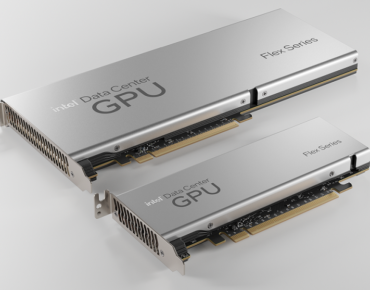Intel Gives a Name to Data Center GPUs for Cloud Gaming and AI

Intel has been hyping up its media delivery and cloud gaming GPUs codenamed Arctic Sound-M, and has given a formal name: Flex Series GPUs.
The Flex Series GPUs will sit in the cloud data centers for AI inferencing and graphics – such as gaming and video – to remote devices. Intel's Vision conference in May was the coming-out party for the GPUs.
Intel hasn't provided a clear shipment date for the Flex GPUs, saying the product shipment would "ramp over the coming months.”
Intel has already delayed data-center products like the Sapphire Rapids server chips, which shipped in small volumes, but whose "ramp" and volume shipments have been delayed to late 2022 or early 2023.
After sitting out for decades, Intel is also just entering the GPU market to compete with Nvidia and AMD. But the ride hasn't been smooth, with product delays, software optimization issues, and poor performance dousing the hype that preceded its GPU launches in the consumer and data center markets.
The GPUs are optimized for OneAPI, which allows developers to write code and AI applications for Intel's hardware. It is an open alternative to Nvidia's CUDA, which is designed for homegrown GPUs.
In May, Intel delayed its Arc GPUs for PCs, and last week acknowledged it was having engineering and software issues.
 The GPU will be available through systems built by server makers that include Dell, HPE and Lenovo. The initial server systems will be for media delivery, Android cloud gaming and inferencing. The GPUs will be optimized for Windows gaming, and virtualization at a later date, Intel said.
The GPU will be available through systems built by server makers that include Dell, HPE and Lenovo. The initial server systems will be for media delivery, Android cloud gaming and inferencing. The GPUs will be optimized for Windows gaming, and virtualization at a later date, Intel said.
Intel executives have also talked about using the GPU as a sort of edge processing device in localized data centers and server environments to support high-performance computing applications such as AI and visualization in larger data centers.
The Flex GPU is a midpoint between the desktop GPUs, and the high-end GPUs designed into mega-chips like future product Ponte Vecchio. Traditionally, GPUs like Flex series were in on-premise workstations, but those applications are moving to the cloud.
Flex chips will sit inside multi-socket servers in scale-up cloud environments. Nvidia dominates the server GPU market, but Intel is counting on some features on Flex to make it competitive.
Intel says its Flex Series 140 GPU decodes video faster while using less power than Nvidia’s A10 chip, which is used for AI and graphics in servers. The Flex GPU can deliver eight concurrent streams of 4K video, and 36 streams of 1080p video per card. Intel also announced the Flex 170 GPU with a higher core count.
The Flex GPU is the first to support hardware decoding for the AV1 codec, which is backed by tech companies such as Google and Microsoft, and streaming heavyweights including Amazon and Netflix. The AV1 spec reduces the bandwidth required to deliver video over the Internet, while retaining the high quality. Intel was an original backer for the AV1 spec.
The GPU can deliver performance of 150 TOPS (trillion operations per second) in graphics and AI performance.
The chip maker did not share full details of the GPUs, but has announced two configurations. The entry level 75-watt option – presumably the Flex 140 – has 16 Xe graphics cores. The 150-watt model – which could be the Flex 170 – has 32 Xe GPU cores. The chips are based on PCIe Gen4, and support GDDR6 memory, and have ray tracing capabilities.











